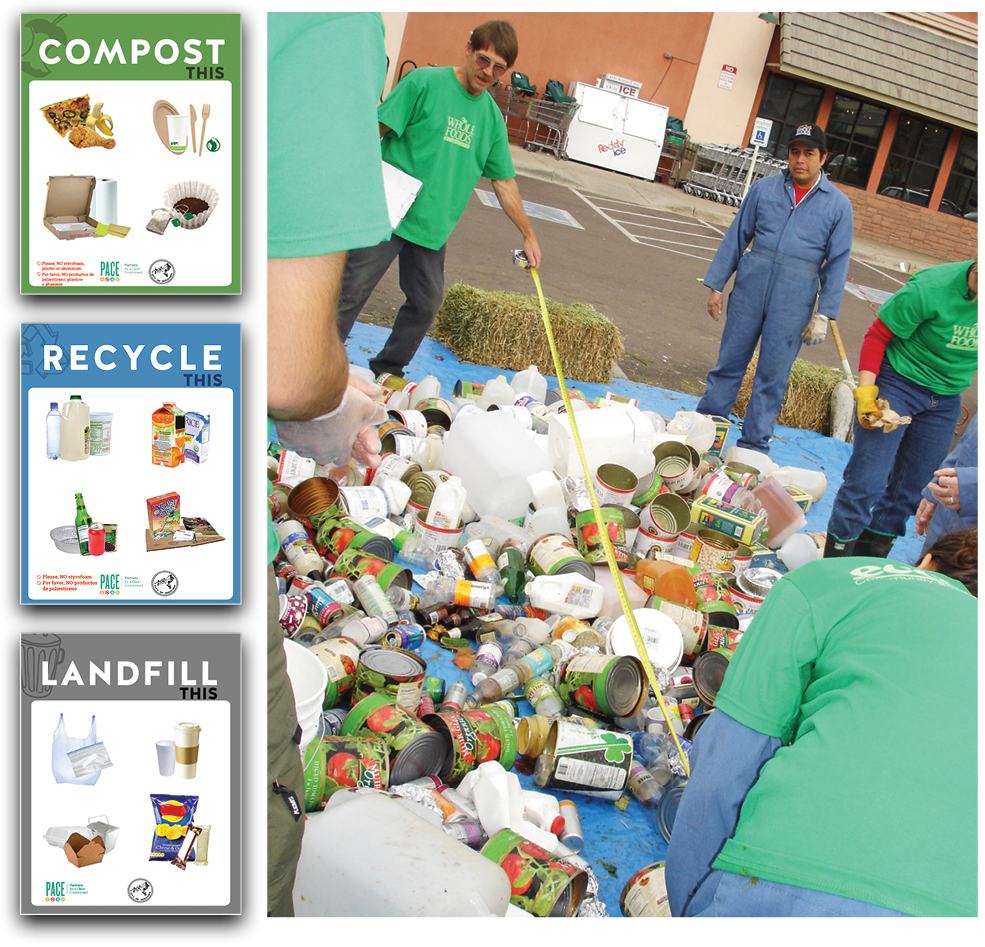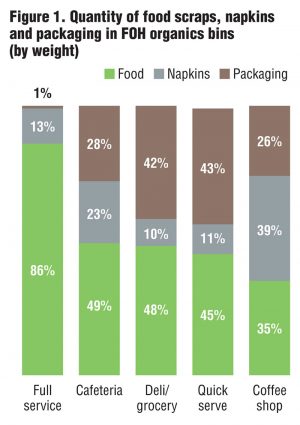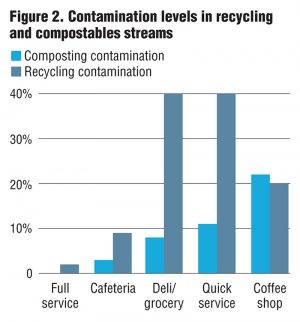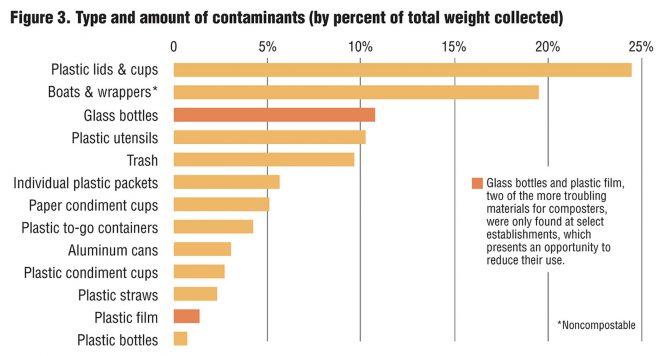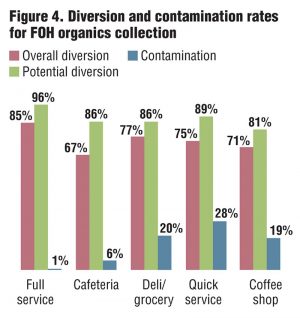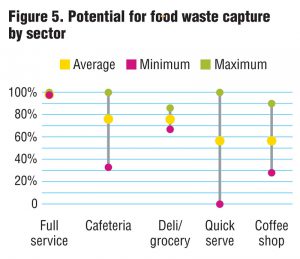Food scraps and napkins made up at least 57 percent of the contents of the composting bin in every sector, contrary to the belief that FOH collections are mostly packaging.
Kate Bailey and Brenna Raeder
BioCycle August 2019
Restaurants play a critical role in reducing and recovering food scraps. Unfortunately, less than 15 percent of restaurant food waste is collected for composting, and this diversion has primarily focused on collecting food scraps from the kitchen. However, on average, diners leave 17 percent of meals uneaten, and 55 percent of these potential leftovers are not taken home. This means there is a large, untapped potential to recover food waste generated by diners through front-of-house (FOH) collection programs.
In 2015, Boulder, Colorado required all businesses, including food establishments, to provide recycling and composting collections for both front- and back-of-house operations. This policy was part of the city’s plan to reach its Zero Waste goal, and seen as an essential strategy to both increase waste diversion rates and educate the community about how and why to participate in Zero Waste programs.
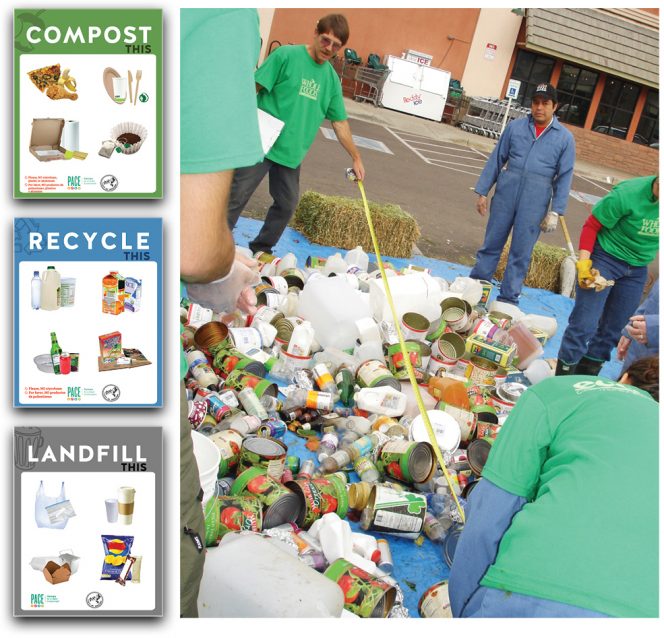
Waste audits (right) were conducted at a variety of food service establishments to determine capture rates, diversion rates and contamination rates for trash, recycling, and composting bins. Having simple, customized and visually-based signs (left) placed on collection bins all grouped together was recommended at all establishments.
Composters have tended to view such FOH programs with skepticism, and even some resistance, due to the perception that customer-facing organics collection means high levels of contamination and a large amount of packaging for a relatively small amount of food scraps. Although there was significant concern about the quality and quantity of organic material collected in FOH bins, there was little to no existing data focused only on FOH collections. This prompted Eco-Cycle, the local nonprofit recycler and a leading Zero Waste advocate, with support from Boulder-based Eco-Products, a manufacturer of compostable foodservice items, to design a waste audit study on FOH source separated organics (SSO) recycling systems. The goals were to learn how bin set-up, signage and packaging can influence how much food waste is collected through FOH systems and to identify strategies to maximize waste diversion from the landfill while minimizing contamination of composting and recycling bins.
The resulting study demonstrates that food establishments of all types can achieve very high diversion rates and capture significant amounts of food scraps through FOH collections, suggesting that FOH collection could be a valuable new source of food scraps for commercial composting facilities and an important local strategy to reduce waste and greenhouse gas emissions.
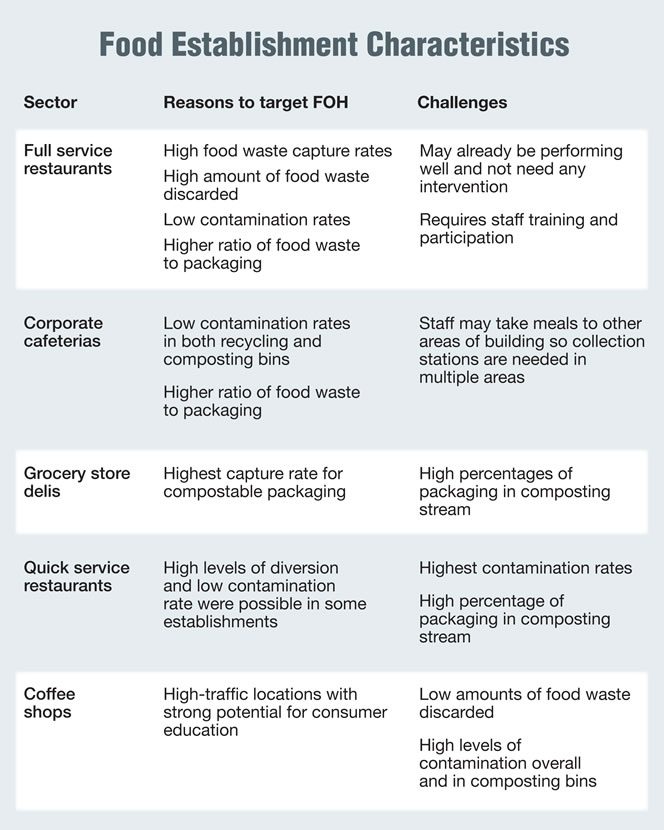
Study Methodology
To evaluate the performance of the FOH programs, waste audits were conducted at 18 businesses across five sectors of foodservice — corporate cafeterias, grocery store delis, quick service restaurants, coffee shops and full service restaurants. The participating businesses represented national chains, regional chains and locally-owned enterprises. Each business already had a three-sort FOH system in place for SSO, recycling and trash, as required by Boulder’s ordinance.
In addition to tracking the amount of waste and its composition at each location, staff also sat and observed how customers used the FOH bins. Based on these observations, changes were made at each business to the placement of the collection bins and/or signs. While this evidence is anecdotal and subjective, it can offer some interesting insights into optimizing FOH collections and best practices for other cities.
Following the first waste audit and the customer observations, changes were then made to placement of collection bins and signage at 10 of the 18 locations in an effort to improve diversion and contamination rates, and a second round of waste audits was conducted to observe any impacts of the bin and signage changes on the diversion rates and contamination levels (the remaining locations were unable to make changes during the project timeline). No changes were made to the type of packaging used or other business practices.
Value Of FOH Collections
The primary goal of FOH SSO collections is to capture more food scraps for composting. Overall, the study results suggest that significantly more food can be recovered for composting through FOH collections, which means including these programs is a valuable strategy to reduce waste and greenhouse gas emissions. Contrary to the belief that FOH collections are mostly packaging, food scraps and napkins made up at least 57 percent of the contents of the SSO bin in every sector, by weight (Figure 1). In addition, the study found that, on average, restaurants are already collecting at least 55 percent of the available food scraps from customers in FOH bins, which shows customers are willing to participate and validates the city of Boulder’s policy to require customer-facing SSO collection bins.
Another common concern about FOH collections is that SSO bins will be highly contaminated. However, contamination in the organics bin was remarkably lower than recycling contamination in all sectors except coffee shops, and three sectors had SSO contamination rates of less than 8 percent (by weight), indicating that FOH collection may provide a fairly clean stream of materials for the composting facility (Figure 2).
Some contaminants are more problematic for composters than others; plastic film and glass are particularly concerning. Plastic film was only found at very low levels and primarily in coffee shops and quick service restaurants, where it could be substituted or avoided by purchasing changes (Figure 3). Glass bottles were only found at quick service establishments, but the heavy weight of the materials skews the data to imply a larger portion of the contamination than was found throughout the study (Figure 3). Given the limited use of glass, some efforts could be made to substitute for other products or to customize signage for better sorting.
Potential For Additional Improvement
The initial waste audit showed that every sector of foodservice was diverting at least 66 percent of its discards already from FOH collections, and that through improved sorting and no changes to the types of packaging used, all foodservice sectors could achieve a potential diversion rate over 80 percent (Figure 4). This demonstrates that restaurants play a critical role in helping their communities reach waste diversion and climate action goals, and that FOH bins are a key part of engaging the entire community on the importance of recycling and composting.
The study also found potential for significant improvement in the capture rates for food scraps at quick service, cafeteria, deli and coffee shop establishments. At least one establishment in every sector was capturing 85 to 100 percent of the available food scraps, indicating that high rates of success are possible in every sector (Figure 5).
Additionally, capture rates for food scraps, overall diversion rates, and overall contamination rates improved at most locations following changes made to the signs and bins during the study. The capture rate for food scraps improved or held steady at 60 percent of locations following changes to the signs and bins, and the capture rate for all compostable materials improved or did not change at 70 percent of locations. This suggests that changes to the collection system are likely to increase the amount of food scraps ending up correctly in the SSO bins. Results, however, were mixed for contamination rates in SSO bins, which only improved with the changes 50 percent of the time. This suggests that changes to bins and signage are not the only steps needed to improve performance and may be most effective when combined with other strategies, as noted in the next section.
Improving Collection Quality
Where infrastructure changes are necessary, observations of customer behavior at FOH bins suggest a few key components for effective signage and bin placement:
• Group bins together: When FOH bins were too far apart or isolated, people dumped everything into the bin regardless of its label.
• Simple, photo-based signs: People took very little time to look at signs and did not read the words.
• Custom signs: Depicting the exact items a customer will be holding (location-specific packaging) might be helpful for efficient sorting.
• Food is not trash: Food scraps that did not end up in the compostables bin were most likely (80%) to end up in the trash can. Signage and other messaging should highlight that food is not trash.
The type of food serviceware used at the restaurant was also important for diversion rates, capture rates and contamination rates. Both the quick service restaurant with all compostable food serviceware and the quick service restaurant with mostly durable food serviceware were top performers with high overall diversion rates, high rates of food waste capture and low contamination rates. Full service restaurants had very high diversion rates, captured nearly all of their food scraps and had very low levels of contamination, in part because of their use of reusable food serviceware. Similarly, the prevalent use of durable food serviceware in cafeterias was correlated to lower contamination rates. This suggests that using all compostable food serviceware or a large amount of durable food serviceware may both be valuable approaches used to achieve these goals.
Finally, the results indicated that the overall type of packaging can have important effects on diversion rates. The total amount of recyclable and compostable packaging was a strong indicator of the overall diversion rate — businesses with a very high percentage of recyclable and compostable packaging had very high diversion rates, and as the percentage of recyclable/compostable packaging declined, diversion rates also declined. This suggests that switching to more recyclable and/or compostable packaging can help improve diversion rates.
Targeted Business Outreach
While the results from this study in Boulder indicate that any sector can improve the quality of FOH SSO collections to achieve diversion rates over 80 percent and capture nearly 85 to 100 percent of food scraps, these results may not translate directly to areas without analogous mandatory Zero Waste programs or a demographic known for its commitment to sustainability. Therefore, initially targeting outreach to specific restaurant types — rather than working with all food businesses at once — might be more effective for composters and cities embarking on these types of programs. For example, full service restaurants are capturing nearly all their food scraps with next to no contamination and have the highest percentage of food scraps in their overall waste stream, so they are likely to be the best candidates for starting high quality FOH organics programs. In addition, cafeterias and delis had less than 8 percent contamination in the organics bins at all locations, suggesting that FOH collection at these businesses can be done with a fairly clean stream of materials for the composting facility.
This study is one of the first of its kind to focus on front-of-house recycling and organics collection. We encourage cities around the world to conduct their own, similar studies in order to build a larger database of best practices and establish a better picture of the impact collection bins, signage, and packaging choices can have on diversion and contamination rates. EcoCycle’s full report and methodology are available online to help guide communities through this process.
Kate Bailey is the Policy & Research Director at Eco-Cycle. Brenna Raeder is an undergraduate student at Denison University and research intern at Eco-Cycle.


